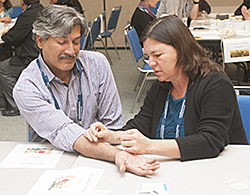
Brenda Golianu, M.D. (right), a presenter at the acupuncture workshop, shows Imran Bhatti, M.D., how to insert a needle into the PC6 area to reduce nausea and vomiting.
For the 15th consecutive year, the annual meeting featured an acupuncture workshop to introduce physician anesthesiologists to treatments once scoffed at by Western physicians but that are now becoming mainstream.
Following 13 presentations by physicians during Monday’s workshop about their use of acupuncture, more than two dozen participants visited five stations to learn how to use acupuncture to relieve side effects related to anesthesia and chemotherapy, and to reduce pain related to a variety of other conditions.
“There is tremendous scientific evidence to support what we are doing as compared to 10-15 years ago. We update the current knowledge of acupuncture to help relieve pain, nausea and vomiting,” said Yuan-Chi Lin, M.D., M.P.H., the session moderator. He is Associate Professor of Anesthesia at Harvard Medical School and Director of Acupuncture Services and Senior Associate in Perioperative Anesthesia and Pain Medicine at Boston Children’s Hospital.
The American Board of Medical Acupuncture certifies physicians to practice acupuncture, with many training programs available around the U.S., including a one-year program at Harvard, he said.
“It is becoming mainstream,” Dr. Lin said. “Yesterday, in a session about the Perioperative Surgical Home, the speaker talked about using acupuncture as a complementary medical therapy integrated as part of the future mainstream of treatments.”
Other presentations Monday explained the background of acupuncture, clarifying that it is the balance between yin and yang, and how it progressed to become accepted in the West. In 1997, the National Institutes of Health issued a consensus statement that acupuncture shows efficacy in “adult postoperative and chemotherapy nausea and vomiting, and in postoperative dental pain.” Today, 20,000 acupuncturists are certified in the U.S., and there are 2,500 medical acupuncturists.
Speakers discussed the clinical practices of acupuncture, which can be used to treat more than 40 disorders, including anxiety, depression, battlefield stress and chemotherapy side effects. More recent studies have looked at its use in treating pain in a variety of other conditions, such as fibromyalgia.
Most often, acupuncture treatment involves sterile, one-time-use needles that are about one-quarter the size of an I.V. needle. Other techniques have been added over the years, including moxibustion, cupping, electrical stimulation, lasers, acupoint injection and ultrasound simulation.
